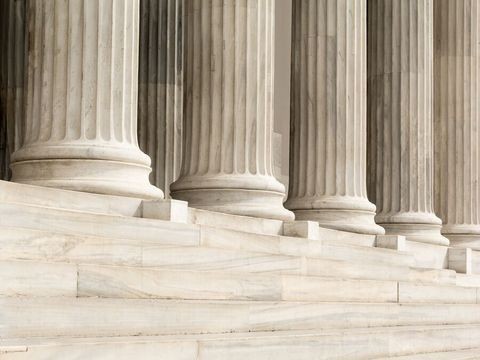U.S. Supreme Court to Decide the Extraterritorial Application of the Lanham Act
Client Alert | 7 min read | 11.08.22
The U.S. Supreme Court is poised to clarify the extraterritorial reach of the Lanham Act for the first time in seventy years. The decision will impact corporations’ ability to seek damages for international trademark infringement, and may resolve a circuit split on the applicability of the Lanham Act on foreign defendants’ foreign conduct. The Court will review the Tenth Circuit’s decision in Abitron Austria GmbH et al. v. Hetronic International Inc. (“Hetronic”) and the extraterritoriality of the Lanham Act, seemingly the Court’s desired outcome after requesting the United States weigh in on Abitron Austria GmbH’s (“Abitron”) certiorari petition filed in January 2022.
The Case Below:
The Supreme Court will review the Tenth Circuit’s decision in Hetronic. 10 F.4th 1016 (10th Cir. 2021). Hetronic Int’l Inc. (“Hetronic”) is a manufacturer of radio remote controls for various types of heavy-duty construction equipment. Hetronic brought a Lanham Act trademark infringement claim against one of its foreign distributors alleging that the distributor had blatantly knocked off its products for sale overseas. The district court awarded Hetronic approximately $90 million in Lanham Act damages, despite the fact that evidence at trial showed that only approximately 3% of offending sales occurred within the United States. In addition to the award of damages attributable to wholly foreign sales, the district court also issued an injunction that purportedly had worldwide effect.
Abitron appealed to the Tenth Circuit, which squarely presented the issue of whether the Lanham Act could be construed to provide for extraterritorial relief against a foreign defendants’ foreign conduct. Although this question was a matter of first impression for the Tenth Circuit, it expressly noted that there were as many as six different tests for extraterritorial application of U.S. statutes in other circuits. In its decision, the Tenth Circuit ultimately held that the Lanham Act could be applied to foreign defendants’ foreign conduct and it upheld, in part, the district court verdict and decision.
The Circuit Splits:
The first step in considering the extraterritorial applicability of any federal statute is to ask whether “the presumption against extraterritoriality has been rebutted, that is whether the statue gives a clear affirmative indication that it applies extraterritorially.” Hetronic at 1034. Steele acknowledged the general presumption against extraterritoriality, but held the Lanham Act could apply abroad at least in some circumstances, namely in relation to U.S. Citizens participating in foreign commerce. Steele v. Bulova Watch Co., 344 U.S. 280, 285–88, (1952) (“Congress has the power to prevent unfair trade practices in foreign commerce by citizens of the United States, although some of the acts are done outside the territorial limits of the United States.”). Congress’s ability to regulate the conduct of its own citizens, even extraterritorial conduct, is generally not an issue of debate. The foreign conduct of foreign defendants affecting U.S. commerce is a different matter. Steele did not resolve whether the Lanham Act could reach foreign defendants nor did it provide an operative test to establish the extraterritorial reach of the Lanham Act.
Various other circuits have interpreted Steele and designed alternative tests to determine whether the Lanham Act should apply to foreign defendants’ foreign conduct. The three primary tests are known as the Vanity Fair test,[1] the Timberlane test,[2] and the McBee test.[3] A majority of the circuits that have considered the issue have adopted some version of the Vanity Fair test, including the Fourth, Fifth, Eleventh, and Federal Circuits. However, the Tenth Circuit adopted the McBee test when it addressed the question of the Lanham Act’s extraterritorial application as a matter of first impression in Hetronic. The McBee tests applies three steps: 1) whether the defendant is a U.S. citizen; 2) when the defendant is not a U.S. citizen, courts should assess whether the defendant’s conduct had a substantial effect on U.S. commerce; and 3) if the plaintiff has satisfied the substantial-effects prong, courts should consider whether extraterritorial application of the Lanham Act would create a conflict with foreign trademark rights and laws. Hetronic at 1036‑38.
The crux of the test is the effects prong. “The substantial effects test requires that there be evidence of impacts within the United States, and these impacts must be of a sufficient character and magnitude to give the United States a reasonably strong interest in the litigation.” McBee, 417 F.3d at 120. Further, a core purpose of the Lanham Act is protecting U.S. consumers from confusion and this core purpose should inform the substantial effects test. Hetronic at 1042. The Tenth Circuit found that Hetronic had presented “more than enough evidence” to prove a substantial effect on U.S. commerce, including evidence of U.S. consumer confusion. Id. at 1042-46. Abitron disagreed with this conclusion and highlighted that 97% of the accused sales were “purely foreign” and “never reached the United States or confused U.S. consumers.” Petition for a Writ of Certiorari at (i), Hetronic, No. 21‑1043 (2022).
The United States Weighs In:
In May, the Supreme Court sought from the United States, by way of the Solicitor General, briefing beyond Abitron’s certiorari petition giving the Biden Administration an opportunity to weigh in on the matter, signaling its interest in the extraterritoriality of the Lanham Act. Solicitor General Elizabeth Prelogar filed an amicus brief on behalf of the United States in September. The United States requested that the Supreme Court review the case and provide clarification on the Lanham Act’s jurisdictional scope, but specifically articulated that the Tenth Circuit’s rationales “are not appropriate bases for extending Lanham Act liability to foreign uses that did not cause a likelihood of confusion in the United States.” Brief for the United States as Amicus Curiae at 9, Hetronic, No. 21‑1043 (2022) (emphasis in original).
Solicitor General Prelogar articulated the question before the Supreme Court as whether under the Lanham Act a party “may recover damages for uses of that trademark that occurred outside the United States and that were not likely to cause consumer confusion in the United States.” Id. at (I). Unlike the Tenth Circuit decision, Prelogar did not focus on the circuit split on the Lanham Act’s applicability to foreign defendants’ foreign conduct and called the split unmoored, complex, and unpredictable. Id. at 21. Instead, Prelogar focused on the presumption against extraterritoriality, reviewing Steele, and concluded the Lanham Act should have extraterritorial effect when the use of a trademark in commerce is “likely to have the ultimate effect of confusing or deceiving consumers in the United States.” Id. at 9-18.
In a mere six weeks since the United States amicus brief and an additional round of supplemental briefing from the parties, the Supreme Court granted Abitron’s petition for certiorari. Although the Supreme Court has considered the extraterritoriality of other federal legislation, it last substantively considered the extraterritoriality of the Lanham Act seventy years ago. Steele at 282–85. Although not yet docketed, this decision will presumably be argued before the Supreme Court next term.
* * *
The Supreme Court is likely to acknowledge the circuit split and nuance in application of the same test across different circuits. In fact, while some tests require a “substantial effect” on U.S. commerce such as the McBee test adopted by the Tenth Circuit in Hetronic, the Ninth and Fifth Circuits only require “some effects,” a markedly different standard. The foreign conduct of a foreign defendant could have a millions dollar difference in liability damages based on the U.S. jurisdiction the case is brought under. This is precisely the discrepancy that Abitron highlights in its certiorari petition while discussing the circuit discrepancy. In other words, conduct that occurs completely abroad and simply has some level of effect on U.S. commerce could have markedly different outcomes in damages based on the U.S. jurisdiction selected.
Given the clear circuit split and the United States amicus brief, the court will hear argument on this case in the near future. The Court will have the opportunity to resolve this material tension in Lanham Act jurisprudence that is only poised to become more significant in an era of worldwide commerce. This case is a must-watch for any company that does business abroad, especially those that use trademarks on items made and/or sold outside the U.S. Crowell & Moring will continue to watch the Hetronic case and ensure our clients are aware of how any decision by the Supreme Court may affect Lanham Act extraterritorial application, specifically client’s ability to enforce trademarks internationally.
[1] The Vanity Fair test was created by the Second Circuit in Vanity Fair Mills, Inc. v. T. Eaton Co., 234 F.2d 633, 642 (2d Cir. 1956).
[2] The Timberlane test was created by the Ninth Circuit in Timberlane Lumber Co. v. Bank of America National Trust & Savings Ass'n, 549 F.2d 597 (9th Cir. 1976) and applied to the Lanham Act in Wells Fargo & Co. v. Wells Fargo Express Co., 556 F.2d 406, 427–28 (9th Cir. 1977).
[3] The McBee test was created by the First Circuit in McBee v. Delica Co., 417 F.3d 107, 117–20 (1st Cir. 2005).
Contacts
Insights
Client Alert | 5 min read | 12.12.25
Eleventh Circuit Hears Argument on False Claims Act Qui Tam Constitutionality
On the morning of December 12, 2025, the Eleventh Circuit heard argument in United States ex rel. Zafirov v. Florida Medical Associates, LLC, et al., No. 24-13581 (11th Cir. 2025). This case concerns the constitutionality of the False Claims Act (FCA) qui tam provisions and a groundbreaking September 2024 opinion in which the United States District Court for the Middle District of Florida held that the FCA’s qui tam provisions were unconstitutional under Article II. See United States ex rel. Zafirov v. Fla. Med. Assocs., LLC, 751 F. Supp. 3d 1293 (M.D. Fla. 2024). That decision, penned by District Judge Kathryn Kimball Mizelle, was the first success story for a legal theory that has been gaining steam ever since Justices Thomas, Barrett, and Kavanaugh indicated they would be willing to consider arguments about the constitutionality of the qui tam provisions in U.S. ex rel. Polansky v. Exec. Health Res., 599 U.S. 419 (2023). In her opinion, Judge Mizelle held (1) qui tam relators are officers of the U.S. who must be appointed under the Appointments Clause; and (2) historical practice treating qui tam and similar relators as less than “officers” for constitutional purposes was not enough to save the qui tam provisions from the fundamental Article II infirmity the court identified. That ruling was appealed and, after full briefing, including by the government and a bevy of amici, the litigants stepped up to the plate this morning for oral argument.
Client Alert | 8 min read | 12.11.25
Director Squires Revamps the Workings of the U.S. Patent Office
Client Alert | 8 min read | 12.10.25
Creativity You Can Use: CJEU Clarifies Copyright for Applied Art
Client Alert | 4 min read | 12.10.25
Federal Court Strikes Down Interior Order Suspending Wind Energy Development



